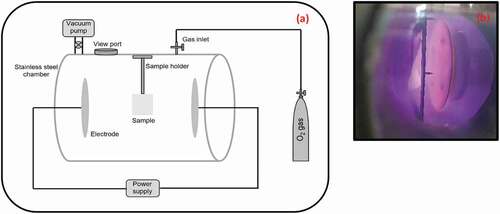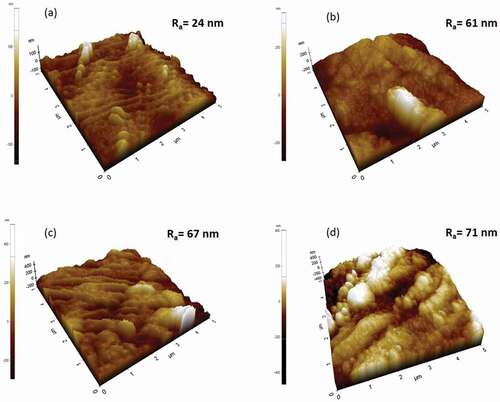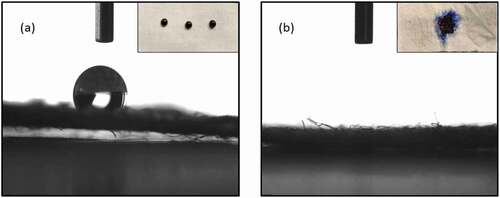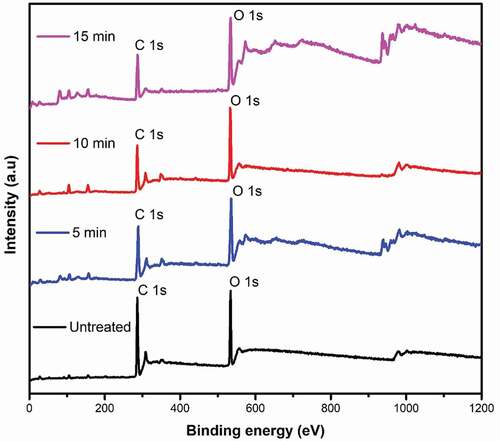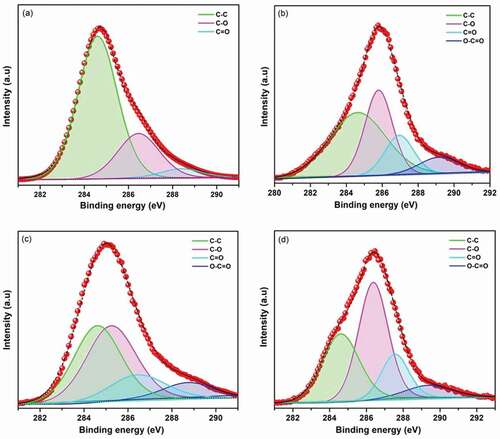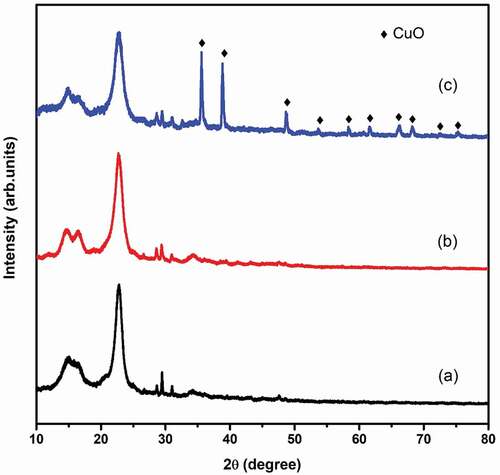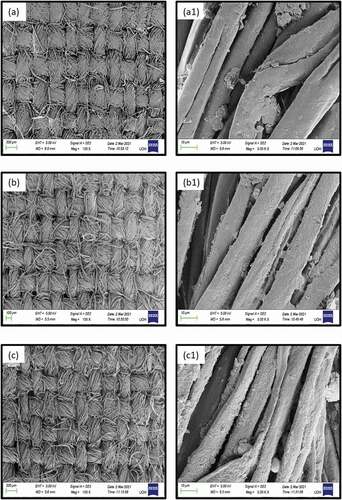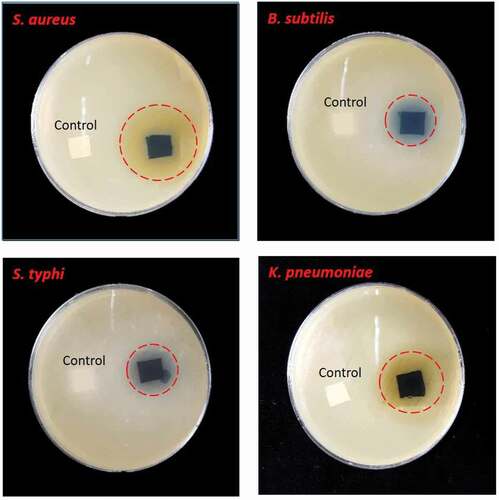ABSTRACT
The present study employs a facile and environmentally cleaner plasma technology to induce adhesion between the cotton fabric and CuO nanoparticles. The oxygen plasma pre-treatment of cotton fabric was performed using DC glow discharge plasma for different plasma treatment times (5, 10 and 15 min) with constant pressure and power. The untreated and plasma treated cotton fabrics were analysed by contact angle, AFM, XPS, XRD, FESEM and elemental mapping analysis. From the AFM results, it is observed that the surface roughness of treated fabric increases with plasma treatment time. XPS analysis reveals that the oxygen plasma treatment introduces oxygen-rich functional groups on the surface which provides the adhesion property of cotton fabric. The 15 min oxygen plasma treated cotton fabric is optimised to coat the CuO nanoparticles based on the AFM and XPS analyses. Furthermore, the CuO nanoparticles coated plasma treated cotton fabric are analysed for antibacterial test and a significant antibacterial activity was identified for gram-positive and gram-negative bacteria.
Graphical abstract

Introduction
Nanoparticles have attained much attention in various fields of science and technology. As particles are scaled down to a nanometre range, the resultant properties are drastically altered. The high surface area to volume ratio of the nanoparticles imports unique electronic, optical, chemical and biological properties as compared to the bulk material. These properties can be manoeuvred for required applications. So far, metal and metal oxide nanoparticles such as Ag, Cu, ZnO, TiO2, CuO and MgO are widely used as antibacterial agents in medical and textile industries [Citation1–4]. Among them, copper and its compounds have been recognised as antimicrobial materials by the US Environmental Protection Agency (EPA) [Citation5]. CuO is relatively economical, easily mixed with polymers and stable because of its physical and chemical properties [Citation6]. In this way, CuO nanoparticles are exclusively used in various promising applications such as wound dressing, bed lining, cotton bandages and medical and food industries [Citation7–11]. The small size and high surface area to volume ratio of the nanoparticles enable them to penetrate through any microbial organisms, causing damage to the enzymatic process and finally leading to the death of bacterial cells [Citation12,Citation13]. Textiles act as an excellent medium for the growth of microbial organisms and thus textile industries are prompted to utilise nanoparticles in medical textiles [Citation14]. Accordingly, CuO nanoparticles are found to be very effective to incorporate into the fabric for the production of potential antibacterial textiles [Citation8,Citation9,Citation15]. Among various synthetic polymers, cotton fabric is regarded as promising material owing to its eco-friendly and bio-degradable nature. Moreover, cotton fabrics are broadly used by incorporating diverse nanoparticles to develop multifunctional properties [Citation14]. Cuticle is the outermost layer which mainly contains waxes, fats, oils, pectin and protein materials which hinders its hydrophilic property [Citation16]. Consequently, the quality of dyeing and finishing of cotton fabric is affected. Various conventional wet chemical methods are practiced for surface modification of fabrics to improve the hydrophilicity. However, those traditional methods consume huge water, energy and harsh chemicals along with polluted effluents which in turn produce a negative impact on the environment [Citation16–19]. Plasma technology, being a clean and dry process is emerging as one of the promising environmentally sound technology for surface modification of fabrics. It acts as an alternate technology owing to its significant advantages such as low cost, energy efficiency, time-saving, green process without harsh chemicals and solvents and thereby no downstream pollution [Citation20–24]. Moreover, it is a water-free technique since it is done in the gas phase and eventually has no waste production. During the plasma treatment, the bombardment of atoms, ions, energetic electrons and free radicals etch the surface of the treated fabric material and resulting in surface modification and functionalization. Plasma surface modification involves nano-scale surface modification without affecting the bulk nature of treated fabric material [Citation21,Citation25]. Plasma treatment of fabrics is emerging as a promising technique to enhance the properties like hydrophilicity, hydrophobicity, wettability, adhesion and dyeability of the treated fabric [Citation16,Citation23]. These functional properties can be easily tailored based on the plasma forming gases. The oxygen plasma treatment is probably the most widely used for enhancing the wettability of textile materials. The formation of polar groups and free radicals increases the surface roughness of fabric which in turn promotes the adhesion between nanoparticles and fabric. K. Vinisha Rani et al. [Citation23], treated cotton fabrics using DC glow discharge oxygen plasma to improve the adhesion of reduced graphene oxide for the electro-conductive property. S. Inbakumar et al. [Citation26] investigated the effect of low-pressure DC glow discharge for different plasma treatment time, discharge power and operating pressure on the physical and chemical properties of cotton fabrics. Vaideki et al. [Citation27], pre-treated cotton fabric with air and oxygen plasma to improve the hydrophilicity for antimicrobial efficacy. S. Anitha et al. [Citation28], treated cotton fabric with DC air plasma to improve the adhesion of neem oil vapour with fabric for antimicrobial application.
In our previously reported work [Citation29], the CuO nanoparticles have been synthesised by recycling copper scrap using the plasma arc discharge method and its antibacterial potential was revealed. To the extent of our knowledge, no reports on a plasma pretreatment of cotton fabric to enhance the adhesion of CuO nanoparticles for antibacterial application are available yet. As a continuation of our previously reported work, herein, cotton fabrics are treated with oxygen plasma for 5, 10 and 15 min to enhance the adhesion between synthesised CuO nanoparticles and cotton fabric. Further, the antibacterial activity of nanoparticles coated plasma pretreated fabric was investigated.
Materials and methods
Materials and plasma pre-treatment of cotton fabric
CuO nanoparticles employed in this work were successfully synthesised from copper scrap by using the Plasma arc discharge method and it was reported in our previous research work [Citation29]. Cotton fabric was purchased from a local textile shop, in Coimbatore, India. The cotton fabric with a dimension of 8 × 8 cm was cleaned with distilled water containing 8% of ethanol and is sonicated for 30 min at room temperature to remove impurities [Citation30,Citation31]. Then, the cotton fabric was dried overnight at room temperature and kept in a desiccator for plasma treatment. The plasma treatment of cotton fabric was performed using a DC glow discharge chamber and its schematic representation is shown in ). It consists of stainless steel chamber with two spherical copper electrodes connected parallel inside it. The electrodes are connected to a high voltage DC power supply with a range of 0 to 1000 V. Initially, the chamber was thoroughly cleaned with acetone before experimenting. The cotton fabric was placed with the help of a sample holder and the chamber was evacuated up to a base pressure of 3 Pa. Oxygen was used as a plasma forming gas and it was allowed to flow inside the chamber. The discharge potential, current, and operating pressure were maintained constant at 300 V, 400 mA, and 9 Pa. The operating pressure was adjusted using a gas needle valve and it was monitored in the Pirani gauge which is connected to the chamber. The cotton fabric was treated with oxygen plasma for different plasma treatment times of 5, 10 and 15 min. The photograph of oxygen plasma is shown in ).
Preparation of CuO nanoparticles coated plasma treated cotton fabric and antibacterial activity
The plasma pre-treated cotton fabric was coated with synthesised CuO nanoparticles using a dip-coating method and allowed to dry overnight at room temperature. The coated fabric was analysed for antibacterial activity against gram-positive (Bacillus subtilis, Staphylococcus aureus) and gram-negative (Salmonella typhimurium, Klebsiella pneumoniae) bacteria using the agar diffusion method [Citation32,Citation33]. The nutrient Muller Hinton agar plate was prepared and test organisms were evenly spread on the solidified medium using a sterile swab stick. The 1 × 1 cm of untreated and plasma pretreated CuO nanoparticles coated cotton fabric were placed on the medium containing bacteria and incubated at 37°C for 18 h. The untreated cotton fabric was used as a control. The antibacterial activity was evaluated based on the measurement of a zone of inhibition (ZOI) around the fabrics. The tests were analysed in triplicate and the average values were reported.
Results and discussion
AFM and contact angle analyses
The surface roughness of the untreated and plasma-treated cotton fabrics is analysed via non-contact mode AFM analysis. 3D AFM images of (a) untreated, (b) 5 min plasma treated, (c) 10 min plasma treated and (d) 15 min plasma treated cotton fabric are illustrated in with corresponding average roughness (Ra) values. The untreated cotton exhibits a flatter surface with an average surface roughness of 24 nm, whereas the roughness of plasma treated cotton fabric increases gradually with an increase in plasma treatment time. The maximum surface roughness of 71 nm was observed for 15 min plasma treatment time. The presence of hills and valleys on the surface of plasma treated fabric was clearly observed in ). During oxygen plasma treatment, two things occur simultaneously: the etching effect caused by the bombardment of highly energetic ions with the surface of cotton fabric and the formation of oxygen-rich functional groups at the cotton surface. The wettability of untreated and oxygen plasma treated cotton fabric was determined using contact angle measurement and shown in . The untreated cotton fabric exhibited a water contact angle of 158° which indicates a hydrophobic nature (inset of )). After oxygen plasma treatment, the surface of cotton fabric turns superhydrophilic (inset of )). Moreover, the rougher surface certainly enhances the wettability of cotton fabric for the development of the hydrophilic property.
XPS analysis
The chemical composition on the surface of the untreated and plasma treated cotton fabrics was studied using XPS analysis. In , the XPS survey spectrum of untreated, 5 min, 10 min and 15 min oxygen plasma treated cotton fabrics are presented. As expected, carbon and oxygen are detected as the main elements of cotton fabric. After oxygen plasma treatment, an increase in the intensity of oxygen peak and a decrease in carbon peak was notified. The relative atomic concentration of carbon and oxygen are calculated from the survey spectra and presented in . From the table, a decrease in carbon and an increase in oxygen concentrations after different plasma treatment times were observed. The oxygen-to-carbon (O/C) ratio gradually increases from 0.35 for the untreated cotton fabric to 0.80 for 15 min oxygen plasma treated cotton fabric. This change in the ratio indicates surface oxidation of cotton fabric because of the use of oxygen plasma. When the surface of cotton fabric is bombarded by active plasma species, the carbon bonds present in cotton get broken and react with oxygen atoms/radicals to form oxygen-rich functional groups, including C-O, C = O and O-C = O [Citation34]. To gain a deeper insight, a high-resolution C 1s scan was performed to determine the types and relative concentrations of different chemical bonds present on the surface of the fabric. C 1s peaks are curve fitted and deconvoluted for further interpretation. shows the C 1s XPS spectra of (a) untreated, (b) 5 min plasma treated (c) 10 min plasma treated and (d) 15 min oxygen plasma treated cotton fabric. The untreated cotton fabric exhibited three peaks corresponding to C-C, C-O and C = O. After different plasma treatment times of 5, 10 and 15 min, a new functional group corresponding to O-C = O was observed. Further, it is clear that the concentration of C-C bonds is decreased whereas the concentration of C-O, C = O and O-C = O bonds is increased after treating cotton fabric in oxygen plasma. From the results, it is evident that oxygen plasma treatment introduces more oxygen-containing polar groups on the surface which in turn promotes the hydrophilic property for better adhesion of nanoparticles onto the cotton fabric. Finally, the 15 min oxygen plasma treatment is selected as the optimum condition for the incorporation of CuO nanoparticles as revealed from the AFM and XPS analyses.
Table 1. Atomic composition and concentration of different chemical bonds on the surface of untreated and plasma treated cotton fabric.
XRD analysis
The XRD pattern of (a) untreated, (b) 15 min plasma treated and (c) CuO nanoparticles coated plasma treated fabric is shown in . The untreated and plasma treated cotton fabric exhibits a similar pattern without change in crystalline nature and bulk property of the cotton fabric. From ), the diffraction peaks observed at 2θ = 35.5°, 38.6°, 48.6°, 53.4°, 58.2°, 61.5°, 66.1°, 68.1°, 72.3° and 75.2° belongs to the monoclinic structure of CuO nanoparticles (JCPDS card No. 895,899). This clearly indicates that CuO nanoparticles are well coated on the plasma treated cotton. The crystallite size of CuO nanoparticles coated in the cotton fabric was found to be 40 nm [Citation29].
FESEM analysis
The surface morphology of the untreated and plasma treated cotton is studied using FESEM analysis. represents the FESEM images of untreated, 15 min plasma treated cotton and CuO nanoparticles coated plasma treated cotton with magnifications of 100 X (a to c) and 3 KX (a1 to c1), respectively. The untreated cotton exhibits a smooth surface whereas oxygen plasma treated cotton fabric has notable morphological changes on its surface. The oxygen plasma roughens the cotton surface due to the etching effect and it provides a pathway for better adhesion of CuO nanoparticles with cotton fabric. From and c1), it can be observed that the CuO nanoparticles are well coated on the plasma treated fabric. The elemental mapping of the CuO nanoparticles coated plasma pre-treated fabric is depicted in . The presence of copper and oxygen elements in ) confirms the coating of CuO nanoparticles on the cotton surface and it can be clearly seen that nanoparticles are evenly coated on the fabric surface.
Antibacterial activity
The antibacterial activity of CuO nanoparticles coated plasma pretreated fabric against gram-positive and gram-negative bacteria is illustrated in where the untreated cotton fabric acts as a control. The CuO nanoparticles used in this work were reported to be about 67 nm in size [Citation29]. The control fabric does not show any inhibition to the tested bacterial organisms, but a clear zone of inhibition around the fabric containing CuO nanoparticles evidences remarkable antibacterial activity. The diameter of the zone of inhibition was measured as 28 mm, 15 mm, 14 mm and 19 mm for S. aureus, B. subtilis, S. typhi and K. pneumoniae organisms, respectively. The antibacterial behaviour of CuO was believed to be in multiple ways, including the release of copper ions in an aquatic medium, adhesion of nanoparticles to bacterial cell walls and damage of DNA [Citation35]. Moreover, the nano-size and high surface area-to-volume ratio of particles easily penetrate through the cell membrane and destroy intracellular proteins. In addition, CuO nanoparticles induce reactive oxygen species (ROS) which leads to lipid peroxidation, protein oxidation, DNA degradation and thereby ends up in bacterial cell death [Citation33,Citation36].
Conclusion
The oxygen plasma pre-treatment of cotton fabric has been performed using DC glow discharge plasma for different plasma treatment times. The surface roughness of fabric increases with an increase in plasma treatment time. The XPS results revealed that oxygen plasma treatment introduces oxygen-rich functional groups on the surface of the fabric which supports the adhesion between nanoparticles and cotton fabric. The XRD study signified that the bulk property of a treated fabric is not altered and confirmed the presence of CuO nanoparticles on the coated fabric. Based on the AFM and XPS results, 15 min oxygen plasma treatment time is chosen to coat the CuO nanoparticles. The nanoparticles coated plasma treated fabric exhibited significant antibacterial activity and can be effectively used in various biomedical applications. Thus, it is concluded that the adoption of plasma technology is a possible alternative for imparting hydrophilic properties to textiles in a cleaner and environmentally friendly manner without any hazardous chemicals as pursued by traditional chemical processes.
Acknowledgments
The authors wish to thank Mr K. Prabu of CSIR-National Chemical laboratory for extending his help in XRD and XPS characterization techniques.
Disclosure statement
No potential conflict of interest was reported by the author(s).
References
- Dizaj SM, Lotfipour F, Barzegar-Jalali M, et al. Antimicrobial activity of the metals and metal oxide nanoparticles. Mater Sci Eng C. 2014;44:278–284.
- Misra RDK, Girase B, Depan D, et al. Hybrid nanoscale architecture for enhancement of antimicrobial activity: immobilization of silver nanoparticles on thiol-functionalized polymer crystallized on carbon nanotubes. Adv Eng Mater. 2012;14:93–100.
- Depan D, Misra RDK. On the determining role of network structure titania in silicone against bacterial colonization: mechanism and disruption of biofilm. Mater Sci Eng C. 2014;34:221–228.
- Hoseinnejad M, Jafari SM, Katouzian I. Inorganic and metal nanoparticles and their antimicrobial activity in food packaging applications. Crit Rev Microbiol. 2018;44:161–181.
- Mahmoodi S, Elmi A, Hallaj Nezhadi S. Copper nanoparticles as antibacterial agents. J Mol Pharm Org Process Res. 2018;06:1–7.
- Vasantharaj S, Sathiyavimal S, Saravanan M, et al. Synthesis of ecofriendly copper oxide nanoparticles for fabrication over textile fabrics: characterization of antibacterial activity and dye degradation potential. J Photochem Photobiol, B. 2019;191:143–149.
- Radetić M, Marković D. Nano-finishing of cellulose textile materials with copper and copper oxide nanoparticles. Cellulose. 2019;26:8971–8991.
- Perelshtein I, Applerot G, Perkas N, et al. CuO-cotton nanocomposite: formation, morphology, and antibacterial activity. Surf Coat Technol. 2009;204:54–57.
- Barua S, Das G, Aidew L, et al. Copper-copper oxide coated nanofibrillar cellulose: a promising biomaterial. RSC Adv. 2013;3:14997–15004.
- Duffy LL, Osmond-McLeod MJ, Judy J, et al. Investigation into the antibacterial activity of silver, zinc oxide and copper oxide nanoparticles against poultry-relevant isolates of salmonella and campylobacter. Food Control. 2018;92:293–300.
- Sun D, Babar Shahzad M, Li M, et al. Antimicrobial materials with medical applications. Mater Technol. 2015;30:B90–B95.
- Camacho-Flores BA, Martínez-Álvarez O, Arenas-Arrocena MC, et al. Copper: synthesis techniques in nanoscale and powerful application as an antimicrobial agent. J Nanomater. 2015;2015:1–10.
- Vincent M, Hartemann P, Engels-Deutsch M. Antimicrobial applications of copper. Int J Hyg Environ Health. 2016;219:585–591.
- Hassabo AG, El-Naggar ME, Mohamed AL, et al. Development of multifunctional modified cotton fabric with tri-component nanoparticles of silver, copper and zinc oxide. Carbohydr Polym. 2019;210:144–156.
- Shahidi S, Jamali A, Dalal Sharifi S, et al. In-situ synthesis of CuO nanoparticles on cotton fabrics using spark discharge method to fabricate antibacterial textile. J Nat Fibers. 2018;15:870–881.
- Nithya E, Radhai R, Rajendran R, et al. Synergetic effect of DC air plasma and cellulase enzyme treatment on the hydrophilicity of cotton fabric. Carbohydr Polym. 2011;83:1652–1658.
- Ibrahim NA, Eid BM. Textile science and clothing technology , edited by Shahid, M, Adivarekar, R. In: Advances in functional finishing of textiles. Singapore: Springer Nature Singapore Pte Ltd; 2020.
- Mather RR. Surface modification of textiles by plasma treatments, edited by Wei, Q. In: Surface modification of textiles. Cambridge: Woodhead Publishing Limited; 2009.
- Sun D, Susheel , K. Biodegrad Green Compos (New Jersey: John Wiley & Sons, Inc.). 2016;18–39.
- Bhat N, Netravali A, Gore A, et al. Surface modification of cotton fabrics using plasma technology. Text Res J. 2011;81:1014–1026.
- Chinnammal KS, Arunkumar KV. Effect of plasma treatment on plain woven cotton fabric. Int J Sci Res. 2014;ETPTA-137:83–88.
- Karthikeyan N, Vijayalakshmi KA, Vignesh K. Effect of glow discharge oxygen plasma treated surface and antimicrobial properties of viscose fabric. Mater Technol. 2016;31:166–175.
- Vinisha Rani K, Sarma B, Sarma A. Plasma treatment on cotton fabrics to enhance the adhesion of reduced graphene oxide for electro-conductive properties. Diam Relat Mater. 2018;84:77–85.
- Buyle G. Nanoscale finishing of textiles via plasma treatment. Mater Technol. 2009;24:46–51.
- Joshi AS, Sharma U, Bais S, et al. Application of plasma finishing on cotton fabric. Int J Eng Res Appl. 2015;5:1–10.
- Inbakumar S, Morent R, de Geyter N, et al. Chemical and physical analysis of cotton fabrics plasma-treated with a low pressure DC glow discharge. Cellulose. 2010;17:417–426.
- Vaideki K, Jayakumar S, Rajendran R. Investigation on the enhancement of antimicrobial activity of neem leaf extract treated cotton fabric using air and oxygen DC plasma. Plasma Chem Plasma Process. 2009;29:515–534.
- Anitha S, Vaideki K, Jayakumar S, et al. Enhancement of antimicrobial efficacy of neem oil vapour treated cotton fabric by plasma pretreatment. Mater Technol. 2015;30:368–377.
- Tharchanaa SB, Priyanka K, Preethi K, et al. Facile synthesis of Cu and CuO nanoparticles from copper scrap using plasma arc discharge method and evaluation of antibacterial activity. Mater Technol. 2021;36:97–104.
- Anupriyanka T, Shanmugavelayutham G, Prakasam R, et al. Surface roughness analysis of cotton fabric by laser speckle technique. Front Adv Mater Res. 2021;3:1–9.
- Shanmugavelayutham G, Anupriyanka T, Bhagyashree P, et al. Plasma surface modification of cotton fabric by using low pressure plasma. IEEE Trans Plasma Sci. 2021;49:497–501.
- Airoudj A, Ploux L, Roucoules V. Effect of plasma duty cycle on silver nanoparticles loading of cotton fabrics for durable antibacterial properties. J Appl Polym Sci. 2015;132:1–9.
- Turakhia B, Divakara MB, Santosh MS, et al. Green synthesis of copper oxide nanoparticles: a promising approach in the development of antibacterial textiles. J Coatings Technol Res. 2020;17:531–540.
- Kan CW, Man WS. Surface characterisation of atmospheric pressure plasma treated cotton fabric-effect of operation parameters. Polymers. 2018;10:250.
- Marković D, Deeks C, Nunney T, et al. Antibacterial activity of Cu-based nanoparticles synthesized on the cotton fabrics modified with polycarboxylic acids. Carbohydr Polym. 2018;200:173–182.
- Ingle AP, Duran N, Rai M. Bioactivity, mechanism of action, and cytotoxicity of copper-based nanoparticles: a review. Appl Microbiol Biotechnol. 2014;98:1001–1009.

